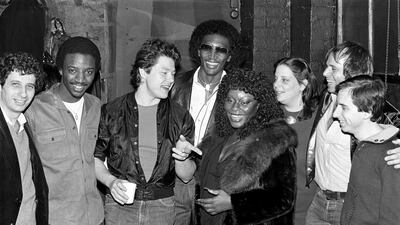Studio 54: New York City
If you’ve been knocked back at a UAE nightclub, you can partly blame this former New York disco institution. Studio 54 gave birth to the “door policy” where staff permit entry only if you satisfy the look the club is going for. Most clubs in the United States had revellers dancing in virtual darkness, but Studio 54 was all about the flashing lights – it was home to an extensive lighting rig and disco balls that crated a bling-tastic effect. The music was all about the latest disco tunes, but the club’s fame came mostly from its celebrity clientele: Liza Minnelli and Andy Warhol, Mick Jagger, Al Pacino and Tommy Hilfiger were regulars. The club closed in 1986, and is now a theatre running under the same name.
Gate Crasher One, Sheffield, England
The club was a former warehouse and opened in 1996 to serve as a home for the Gatecrasher dance brand, which until then, was running one-off parties across the United Kingdom. Built in the postmodernist style, with various lounges and a VIP area, the venue became a global ambassador for the UK dance and techno scene, and its spin-off CD compilations were big sellers. The club night came to an end in 2007 when the venue partially collapsed as a result of a fire. It was redeveloped in 2016 into student accommodation buildings called Gatecrasher Apartments.
Space, Ibiza, Spain
As the Grand Poobah of the island’s scene, Space was banging out the dance tunes for more than 30 years, in a run that began in 1986, long before Ibiza was famous for its club life. Initially opening with the aim of pleasing travellers, it was in the early 1990s that it got serious about its music pedigree, becoming home to techno legend Carl Cox. The British DJ had a near 15-year residency at the club with his Music is Revolution parties. Another key feature of Space was its outdoor terrace near an aeroplane landing path: revellers had the opportunity to dance while low-flying aircraft roared above. Space closed in 2016, only for the venue to open a year later under the name Hi Ibiza.
Le Palace, Paris, France
The venue formed the heart of Paris’s entertainment scene over a seven-year run that began in 1978. Launched by French nightclub impresario Fabrice Emaer, who was then dubbed “The Prince of the Night”, the club’s charm lay in it being able to maintain its 1930s theatre heritage, while being uber-chic. In addition to the on-point musical selection, the club pulled in big names each weekend, such as Mick Jagger (pictured), Andy Warhol, model and singer Grace Jones and actress Alice Sapritch to name a few. The club ended when Emaer passed away in 1983. It is now a performance venue for theatre and television broadcasts.
Paradise Garage, New York City, USA
Operating for a decade from 1977, Paradise Garage has been credited for inventing house music. From the get-go, it was no-fuss, and all about the music. It hosted one of the best sound systems in New York City and was known as a place for dancing, not socialising. It is for that reason that DJs had to bring their A-game. Paradise Garage’s crowds were known for their brutal booing and insulting struggling DJs. That quest by the audience for excellence resulted in the club’s regular performers Frankie Knuckles and Nicky Siano laying down the musical roots of what came to be house.
__________________
Read more:
UK’s fabled superclub The Hacienda gets the strings treatment at Dubai Opera
The Hacienda is rebuilt in the UAE
It is finally here: Spotify has launched in the Middle East and North Africa


